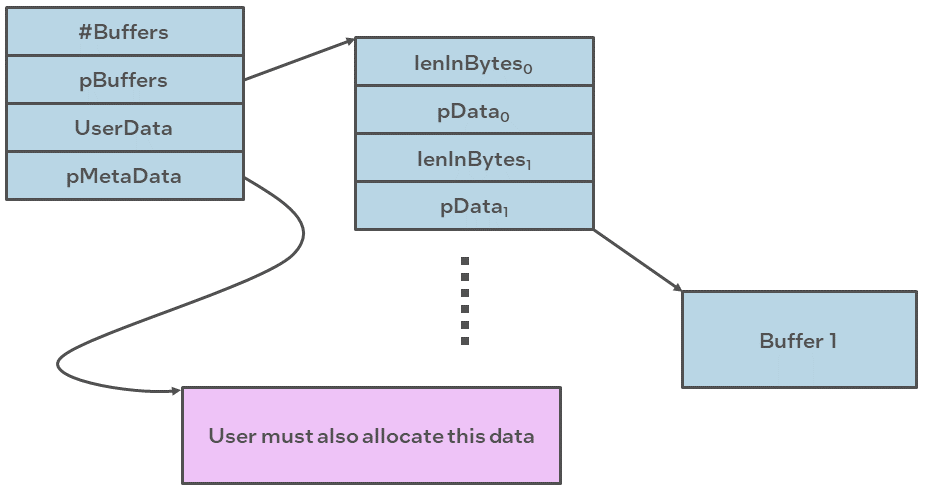Memory Management
This section describes memory management requirements for submitting buffers to the QAT hardware.
DMA-able Memory
If SVM is not enabled, Memory passed to Intel® QuickAssist Technology hardware must be DMA’able.
Physically contiguous (can also deal with Scatter Gather Lists).
Physically addressed.
If VT-d is enabled (e.g. in virtualized system), then Intel IOMMU will translate to host physical addresses as needed.
Pinned (i.e. locked, guaranteed resident in physical memory).
Intel provides a User Space DMA-able Memory (USDM) component (kernel driver and corresponding user space library) which allocates/frees DMA-able memory, mapped to user space, performs virtual to physical address translation on memory allocated by this library
This component is used by the sample code supplied with the user space library.
Memory Type Determination
QAT 2.0 hardware offers the application to use virtual memory directly to sending the acceleration requests and saving the memory copy overhead. However, different SVM configurations will result in different memory types. The QAT package offers memory management library called User Space DMAable Memory(USDM) to help user space applications using the pinned memory.
SVMEnabled |
ATEnabled |
Memory Type |
FALSE(0) |
FALSE(0) |
Pinned Memory (USDM) |
TRUE(1) |
FALSE(0) |
Pinned Memory (USDM) |
FALSE(0) |
TRUE(1) |
Invalid configuration |
TRUE(1) |
TRUE(1) |
Pinned Memory (USDM) or Dynamic Memory (malloc/ zalloc/mmap…) |
Buffer Formats
Data buffers are passed across the API interface in one of the following formats:
Flat Buffers represent a single region of physically contiguous memory.
Scatter-Gather Lists (SGL) are essentially an array of flat buffers, for cases where the memory is not all physically contiguous.
Flat Buffers
Flat buffers are represented by the type CpaFlatBuffer, defined in the file cpa.h. It consists of two fields:
Data pointer
pData: points to the start address of the data or payload. The data pointer is a virtual address; however, the actual data pointed to is required to be in contiguous and DMAable physical memory. This buffer type is typically used when simple, unchained buffers are needed.Length of this buffer:
dataLenInBytesspecified in bytes.
For data plane APIs (cpa_sym_dp.h and cpa_dc_dp.h), a flat buffer is represented by
the type CpaPhysFlatBuffer, also defined in cpa.h. This is similar to the
CpaFlatBuffer structure; the difference is that, in this case, the data pointer,
bufferPhysAddr, is a physical address rather than a virtual address.

Scatter-Gather List (SGL) Buffers
A scatter-gather list is defined by the type CpaBufferList, also defined in the file
cpa.h. This buffer structure is typically used where more than one flat buffer can be
provided to a particular API. The buffer list contains four fields, as follows:
The number of buffers in the list.
pBuffers: pointer to an unbounded array of flat buffers.UserData: an opaque field; is not read or modified internally by the API. This field could be used to provide a pointer back into an application data structure, providing the context of the call.pMetaData: pointer to metadata required by the API:The metadata is required for internal use by the API. The memory for this buffer needs to be allocated by the client as contiguous data. The size of this metadata buffer is obtained by calling
cpaCyBufferListGetMetaSizefor crypto,cpaBufferLists, andcpaDcBufferListGetMetaSizefor data compression.The memory required to hold the
CpaBufferListstructure and the array of flat buffers is not required to be physically contiguous. However, the flat buffer data pointers and the metadata pointer are required to reference physically contiguous DMAable memory.There is a performance impact when using scatter-gather lists instead of flat buffers. Refer to the Performance Optimization Guide for additional information.
Scatter-Gather list (SGL) buffers should not have more than 256 entries.

For data plane APIs (cpa_sym_dp.h and cpa_dc_dp.h) a region of memory that is not
physically contiguous is described using the CpaPhysBufferList structure. This is
similar to the CpaBufferList structure; the difference, in this case, the individual flat
buffers are represented using physical rather than virtual addresses.
Huge Pages (Hugepages)
The included User space DMAable Memory driver USDM supports 2MB pages. This allows direct access to main memory by devices other than the CPU. However, the actual supported maximum memory size in one individual allocation when huge pages are enabled is slightly less than the full 2MB page size, specifically 2MB - 5KB. The 5KB is reserved for memory management purposes by the memory driver itself, leaving 2MB - 5KB available for actual data storage. The use of 2MB pages provides benefits, but also requires additional configuration. Use of this capability assumes that a sufficient number of huge pages are allocated in the operating system for the particular use case and configuration.
Out-Of-Tree Example Use cases
Here are some example use cases that apply to the USDM driver included with the Out-Of-Tree package:
Default settings applied:
modprobe usdm_drv.koSet maximum amount of Non-uniform Memory Access (NUMA) type memory that the User Space DMAable Memory (USDM) driver can allocate to 32MB for all processes. Huge pages are disabled:
modprobe usdm_drv.ko max_mem_numa=32768Set maximum number of huge pages that the USDM can allocate to 50 in total and 5 per process:
modprobe usdm_drv.ko max_huge_pages=50 max_huge_pages_per_process=5
Note
This configuration works for up to the first 10 processes.
Here are examples of invalid use cases to avoid:
This is erroneous configuration, maximum number of huge pages that USDM can allocate is 3 totals: 3 for a first process, 0 for the next processes:
insmod ./usdm_drv.ko max_huge_pages=3 max_huge_pages_per_process=5This command results in huge pages being disabled because
max_huge_pagesis 0 by default:insmod ./usdm_drv.ko max_huge_pages_per_process=5This command results in huge pages being disabled because
max_huge_pages_per_processis 0 by default:insmod ./usdm_drv.ko max_huge_pages=5
Note
The use of huge pages may not be supported for all use cases. For instance, depending on the driver version, some limitations may exist for an Input/Output Memory Management Unit (IOMMU).